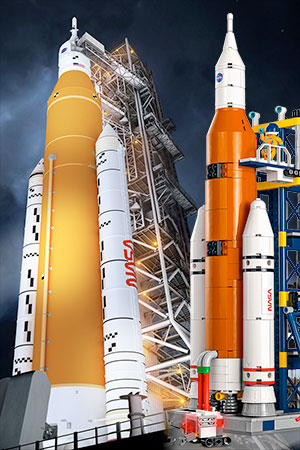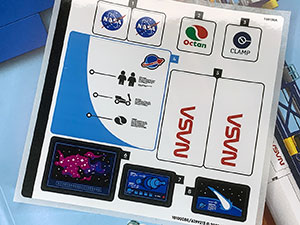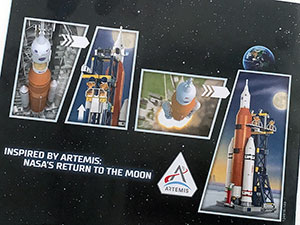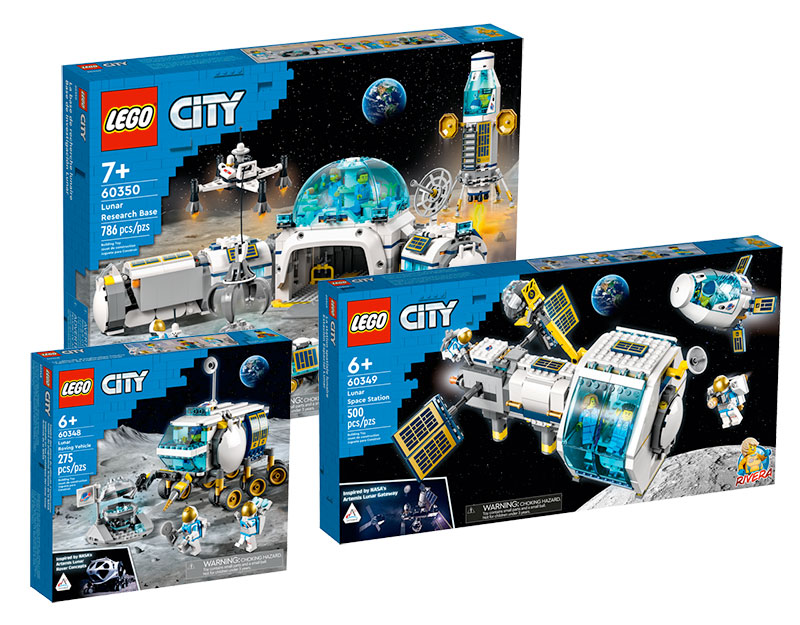 advertisements advertisements
|

|
LEGO rolls out Artemis toy sets ahead of new NASA moon missions
March 2, 2022 — LEGO rolled out its version of NASA's Space Launch System (SLS) on Tuesday (March 1), two weeks before the space agency was scheduled to do the same with the real moon-bound rocket.
The toy company released the SLS and three other sets inspired by NASA's Artemis program as part of an expansion to its long-running City line. The new kits are based on the major components of NASA's return to the moon, from the SLS ("Rocket Launch Center") to the Gateway ("Lunar Space Station"), moon base ("Lunar Research Base") and habitable mobility platform ("Lunar Roving Vehicle").
The SLS, which, itself, is part of the largest of the four new sets, comes closest to its real-life inspiration in both details and timing. NASA is preparing to roll out the massive booster from its assembly building to the launch pad this month, prior to its first launch later this summer. The Artemis I mission will send an uncrewed Orion spacecraft on a three-week flight beyond the moon to assess the vehicles' performance before beginning to fly astronauts.
Ultimately, NASA plans to use Orion and SLS, as well as a SpaceX-built human landing system to return Americans to the lunar surface, including the first woman and the first person of color.
The SLS in the LEGO Rocket Launch Center (set no. 60351) stands more than 16.5 inches tall and 4 inches wide (42 by 11 cm) when assembled, roughly 235 times smaller than the rocket on which it is based. Like the real SLS, though, the toy vehicle comprises a core stage with four rear mounted engines and two side mounted boosters (although the LEGO versions are noticeably more stocky than their full-size counterparts).
Designed with playability in mind — the set is intended for children ages 7 and older — the SLS is too small to accommodate LEGO minifigures inside its Orion spacecraft and so the core stage diverges from reality, with compartments for a cockpit, a payload bay with an included lunar rover and a fuel tank, the latter the only component of the real hardware. (An "easter egg" is included here in the form a decal that adds the logo of LEGO's fictional gas station brand, "Octan," to the fuel tank, cluing in kids to what the tank is meant to hold.)
The set also includes a launch support tower decked out in blue (rather than the real gantry's steel gray) and outfitted with a crew elevator that can be raised and lowered, as well as a retractable crew walkway leading out to the rocket. At the base of the SLS are also two umbilical lines to feed fuel into the core stage's tank. The feedlines automatically retract as the rocket lifts off (i.e. when you lift the SLS off its platform).
The SLS is the only model among the new sets to include decals with NASA's logos, both the round "meatball" insignia and once-retired "worm" logotype as are emblazoned on the real rocket. Missing are decals of the American flag and the European Space Agency (ESA) logo, the latter representing Europe's contribution of the Orion service module as adorns the real rocket.
The LEGO Rocket Launch Center includes 1,010 pieces, which in addition to the SLS are used to also build a launch control center, an observation dome, a service vehicle and a drone. The set also comes with six minifigures, including two astronauts "dressed" in the same style orange pressure suits (but with different faces and hairstyles) as the four minifigures packed on board the real Artemis I as part of an educational outreach partnership between LEGO Education and NASA.
As with the other new space sets, the box art and back of one of the instruction books for the Rocket Launch Center display the Artemis logo and photos showing the NASA inspiration for the toys. With the exception of the inclusion of VIPER, NASA's Volatiles Investigating Polar Exploration Rover, as part of the Lunar Research Base, the other sets rely more on early NASA artist concepts and LEGO designers' imaginations than the SLS, given the status of the Artemis program.
The Lunar Research Base (set no. 60350) is the second largest in the series, with 786 pieces used to build VIPER, a domed accommodation module with labs, a garage, an airlock and six minifigures. The base's airlock can be connected to the Lunar Roving Vehicle (set no. 60348), which is a separate build from 275 pieces (including three minifigures).
Lastly, the Lunar Space Station (set no. 60349) is loosely based on the Gateway, a human-tended way station planned to orbit the moon in support of astronauts arriving from Earth on Orion, as well as descending to and rising from the moon's surface aboard the human landing system. LEGO's version is assembled from 500 pieces including science and botany labs and a docking space capsule (which is very loosely based on Orion), plus five astronaut minifigures.
Altogether, the four new sets represent the infrastructure NASA says it needs to prepare astronauts to fly onto Mars and into deep space in the future. For LEGO, the sets provide opportunities for learning, offering imaginative, open-ended play based on real-life space missions.
Available for sale at LEGO Stores and on LEGO's website as of Tuesday (March 1), the Rocket Launch Center retails for $149.99, the Lunar Research Base lists for $119.99, the Lunar Space Station is $79.99 and Lunar Roving Vehicle $39.99. |
|

LEGO has debuted its version (at right) of NASA's Space Launch System (SLS) rocket (at left, artist rendering) ahead of the Artemis I mission launching to the moon. (NASA/LEGO/collectSPACE)

The LEGO Rocket Launch Center set includes decals to adorn the Space Launch System (SLS) rocket with NASA's "meatball" and "worm" logos, as are on the real-life booster. (collectSPACE)

Graphics on the sets' boxes and included with the build instructions illustrate where LEGO drew inspiration for the toys from NASA's Artemis program vehicles and support hardware. (collectSPACE) |

In addition to the Rocket Launch Center with its version of NASA's Space Launch System (SLS) rocket, the new LEGO City Space sets include the Lunar Research Base, Lunar Roving Vehicle and Lunar Space Station. (LEGO/collectSPACE) |
|
When you purchase through links on our site, we may earn an affiliate commission. Here's how it works.

© collectSPACE. All rights reserved.
|
|

|

|
